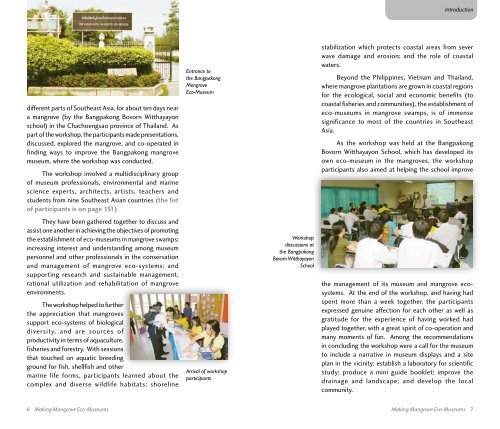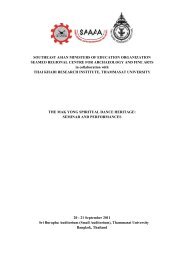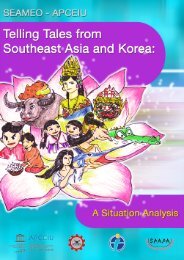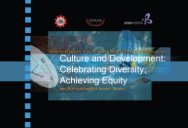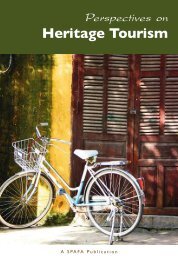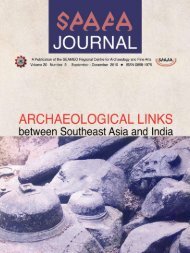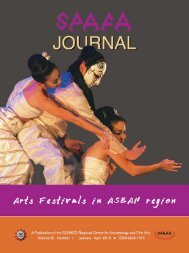Making Mangrove - Seameo-SPAFA
Making Mangrove - Seameo-SPAFA
Making Mangrove - Seameo-SPAFA
Create successful ePaper yourself
Turn your PDF publications into a flip-book with our unique Google optimized e-Paper software.
IntroductionIntroductiondifferent parts of Southeast Asia, for about ten days neara mangrove (by the Bangpakong Bovorn Witthayayonschool) in the Chachoengsao province of Thailand. Aspart of the workshop, the participants made presentations,discussed, explored the mangrove, and co-operated infinding ways to improve the Bangpakong mangrovemuseum, where the workshop was conducted.The workshop involved a multidisciplinary groupof museum professionals, environmental and marinescience experts, architects, artists, teachers andstudents from nine Southeast Asian countries (the listof participants is on page 151).Entrance tothe Bangpakong<strong>Mangrove</strong>Eco-Museumstabilization which protects coastal areas from severwave damage and erosion; and the role of coastalwaters.Beyond the Philippines, Vietnam and Thailand,where mangrove plantations are grown in coastal regionsfor the ecological, social and economic benefits (tocoastal fisheries and communities), the establishment ofeco-museums in mangrove swamps, is of immensesignificance to most of the countries in SoutheastAsia.As the workshop was held at the BangpakongBovorn Witthayayon School, which has developed itsown eco-museum in the mangroves, the workshopparticipants also aimed at helping the school improveThey have been gathered together to discuss andassist one another in achieving the objectives of promotingthe establishment of eco-museums in mangrove swamps;increasing interest and understanding among museumpersonnel and other professionals in the conservationand management of mangrove eco-systems; andsupporting research and sustainable management,rational utilization and rehabilitation of mangroveenvironments.The workshop helped to furtherthe appreciation that mangrovessupport eco-systems of biologicaldiversity, and are sources ofproductivity in terms of aquaculture,fisheries and forestry. With sessionsthat touched on aquatic breedingground for fish, shellfish and othermarine life forms, participants learned about thecomplex and diverse wildlife habitats; shorelineArrival of workshopparticipantsWorkshopdiscussions atthe BangpakongBovorn WitthayayonSchoolthe management of its museum and mangrove ecosystems.At the end of the workshop, and having hadspent more than a week together, the participantsexpressed genuine affection for each other as well asgratitude for the experience of having worked hadplayed together, with a great spirit of co-operation andmany moments of fun. Among the recommendationsin concluding the workshop were a call for the museumto include a narrative in museum displays and a siteplan in the vicinity; establish a laboratory for scientificstudy; produce a mini guide booklet; improve thedrainage and landscape; and develop the localcommunity. <strong>Making</strong> <strong>Mangrove</strong> Eco-Museums<strong>Making</strong> <strong>Mangrove</strong> Eco-Museums


